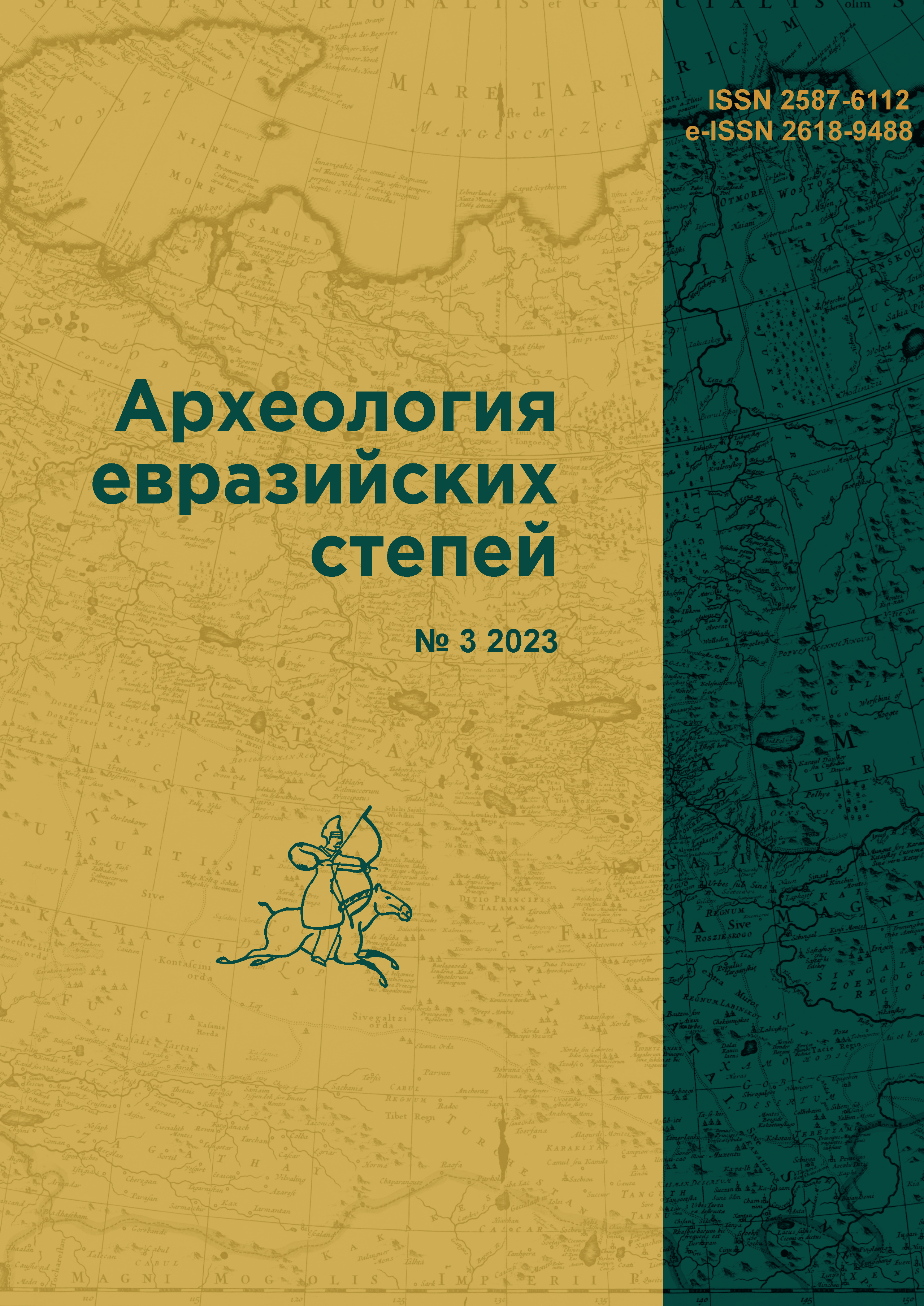Stone Scrapers of the Kurmanakovo IV Site of the Late Bronze Age in the Lower Kama Region: morphological and functional analysis
DOI:
https://doi.org/10.24852/2587-6112.2023.3.121.135Keywords:
archaeology, Lower Kama region, Myosha river, Late Bronze Age, textile ceramics culture, Atabayevo stage of the Maklasheyevka culture, dwelling, scrapers, morphology, use-wear analysisAbstract
Scrapers as a category of stone inventory of the Late Bronze Age cultures in Kazan Volga River and Kama River’s mouth regions is poorly covered in generalizing studies. Usually, only quantitative indicators of morphologically expressed stone tools from the areas of settlements are given in the literature. In this paper morphological and functional analyses of stone scrapers found mainly in dwelling 1 of the Kurmanakovo IV site are presented. According to the ceramic material, four cultural and chronological horizons are marked out.
At the same time, the main horizon associated with the construction of a complex of dwellings on this territory falls on the XIV–XIII centuries BC with the time of the existence of the textile ceramics culture and the Atabayevo stage of the Maklasheyevka culture. Judging by the revealed analogies and spatial analysis, most
of the scrapers were related with this cultural chronological horizon. As a result of morphological and functional analyses, five morphological groups of scrapers were identified. Functionally, the scrapers were divided into two groups; scrapers for soft material (hide, skin) and scrapers for hard material (wood). Use-wear study made it possible to increase the number of functional groups of scrapers and identify combined tools among them.
References
Ashikhmina, L. I. 2014. Genezis anan’inskoi kul’tury v Srednem Prikam’e (po materialam keramiki i zhilishch) (Genesis of the Ananyino Culture in the Middle Kama Area (According to the Ceramics and Dwellings)). Series: Arkheologiia evraziiskikh stepei (Archaeology of the Eurasian Steppes) 19. Kazan: Institute of Archaeology named after A. Kh. Khalikov, Tatarstan Academy of Sciences; “Otechestvo” Publ. (in Russian).
Galimova, M. Sh. 2010. In Uchenye zapiski Kazanskogo gosudarstvennogo universiteta. Seriia Gumanitarnye nauki (Scientific Bulletin of the Kazan State University. Series: Humanities). Vol. 152, book 3, part 1, 30–41 (in Russian).
Galimova, M. Sh. 2014. In Kuzminykh, S. V., Chizhevsky, A. A. (eds.). Anan’inskii mir: istoki, razvitie, sviazi, istoricheskie sud’by (The World of Ananyino: Origins, Evolution, Relations, Historical Fate). Series: Arkheologiia Evraziiskikh stepei (Archaeology of Eurasian Steppes) 20. Kazan: “Otechestvo” Publ., 187–191 (in Russian).
Zbrueva, A. V. 1960. In Smirnov, A. P. (ed.). Trudy Kuybyshevskoi arkheologicheskoi ekspeditsii (Proceedings of the Kuybyshev Archaeological Expedition) 3. Materialy i issledovaniia po arkheologii SSSR (Materials and Studies in the USSR Archaeology) 80. Moscow: Academy of Sciences of the USSR, 10–95 (in Russian).
Kalinin, N. F., Khalikov, A. Kh. 1954. In Smirnov, A. P. (ed.). Trudy Kuybyshevskoi arkheologicheskoi ekspeditsii (Proceedings of the Kuybyshev Archaeological Expedition) I. Series: Materialy i issledovaniia po arkheologii (Materials and Studies in the Archaeology) 42. Moscow: Academy of Sciences of the USSR, 157–246 (in Russian).
Korobkova, G. F., Shchelinskii, V. E. 1996. Metodika mikro-makroanaliza drevnikh orudii truda (Methodology of Micro- and Macroanalysis of Prehistoric Implements) 1. Saint Petersburg: Institute for the History of Material Culture, Russian Academy of Sciences (in Russian).
Lyganov, A. V. 2019. In Povolzhskaya arkheologiya (Volga River Region Archaeology) 29 (3), 34–50. DOI: 10.24852/pa2019.3.29.34.50 (in Russian).
Lyganov, A. V. 2019a. In Lopatin, N. V. (ed.). Arkheologicheskie otkrytiia 2017 g. (Archaeological Discoveries in 2017). Moscow: Institute of Archaeology of the Russian Academy of Sciences, 339–340
(in Russian).
Lyganov, A. V. 2021. In Arkheologiia Evraziiskikh stepei (Archaeology of Eurasian Steppes) 2. 29–46
(in Russian).
Lyganov, A. V., Morozov, V. V., Azarov, E. S. 2019. In Arkheologiia Evraziiskikh stepei (Archaeology of Eurasian Steppes) 2. 38–98 (in Russian).
Lyganov, A. V., Khamzin, R. N., Galimoa, M. Sh. 2018. In Povolzhskaya arkheologiya (Volga River Region Archaeology) 25 (3), 242–257 (in Russian).
Nikitin, V. V. 2017. Na grani epokhi kamnya i metalla. Srednevolzhskiy variant volosovskoy kul'turno-istoricheskoy obshhnosti (Between the Stone and Metal Periods. Middle Volga Variation of the Volosovo Cultural and Historical Community). Series: Arkheologiia Povolzhia i Urala. Materialy i issledovaniia (Volga and the Urals Archaeology. Materials and Studies) 10. Yoshkar-Ola: Mari State University (in Russian).
Poplevko, G. N. 2007. Metodika kompleksnogo issledovaniia kamennykh industrii (Methodology of the Complex Studies of Stone Industries). Series: Труды Института истории материальной культуры (Proceedings of the Institute for the History of Material Culture, Russian Academy of Sciences) XXII. Saint Petersburg: Institute for the History of Material Culture, Russian Academy of Sciences, “Dmitrii Bulanin” Publ. (in Russian).
Poplevko, G. N., Grechkina T. Yu. 2016. In Izvestiia Samarskogo nauchnogo tsentra Rossiiskoi Akademii nauk (Proceedings of the Samara Scientific Center, Russian Academy of Sciences). Vol. 18, no. 6. 157–169 (in Russian).
Skakun, N. N., Terekhina, V. V., Esakiia, K. M. 2017. In Povolzhskaya arkheologiya (Volga River Region Archaeology) 21 (3), 89–97 (in Russian).
Solov’ev, B. S. 2000. Bronzovyi vek Mariiskogo Povolzh’ia (Bronze Age of Mari Volga Area). Series: Trudy Mariyskoy arkheologicheskoy ekspeditsii (Proceedings of the Mari Archaeological Expedition) VI. Yoshkar-Ola: Mari Research Institute of Language, Literature, and History (in Russian).
Filippov, A. K. 1983. In Rogachev, A. N. (ed.). Tekhnologiia proizvodstva v epokhu paleolita (Manufacturing Technology in the Paleolithic Period). Leningrad: “Nauka” Publ., 9–71 (in Russian).
Khalikov, A. Kh. 1980. Prikazanskaia kul’tura (The Prikazanskaya Culture). Series: Svod Arkheologicheskikh Istochnikov (Corpus of Archaeological Sources) 1-24. Moscow: “Nauka” Publ. (in Russian).
Chizhevsky, A. A. 2007. In Galimova, M. Sh (ed.). Arkheologiia i estestvennye nauki Tatarstana (Archaeology and Natural Sciences of Tatarstan) 3. Kazan: “Alma-Lit” Publ., 93–112 (in Russian).
Chizhevsky, A. A., Galimova, M. Sh., Gubaidullina, A. M. 2019. In Arkheologiia Evraziiskikh stepei (Archaeology of Eurasian Steppes) 2. 124–164 (in Russian).

Downloads
Published
How to Cite
Issue
Section
License
Copyright (c) 2023 E.N. Golubeva, A.V. Lyganov

This work is licensed under a Creative Commons Attribution-NonCommercial 4.0 International License.







